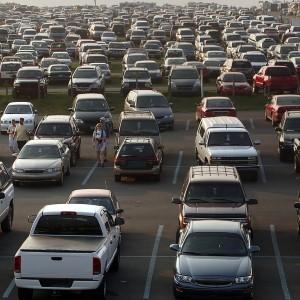 Our daily travels can often be mapped out as a series of parking lots that we travel to and from. My short two and one half mile journey to work each morning takes me by no less than 50 surface lots. This does not even account for the multi-story parking complexes and the numerous parking spaces along the street. Considering surface lots alone, studies have shown that about one third of urban surfaces could be covered by parking lots. Typically black topped and equipped with curbs and drains to quickly funnel water away; parking spaces are maximized by minimizing, if not eliminating, plants and trees. This produces a rather hot, sterile environment right in the middle of our daily lives.
Our daily travels can often be mapped out as a series of parking lots that we travel to and from. My short two and one half mile journey to work each morning takes me by no less than 50 surface lots. This does not even account for the multi-story parking complexes and the numerous parking spaces along the street. Considering surface lots alone, studies have shown that about one third of urban surfaces could be covered by parking lots. Typically black topped and equipped with curbs and drains to quickly funnel water away; parking spaces are maximized by minimizing, if not eliminating, plants and trees. This produces a rather hot, sterile environment right in the middle of our daily lives.
When we take a moment to think about these anti-oases; most of us would be happy if the parking spaces were a little closer to where we needed to be, a little cooler for our cars, less expensive to our wallets (where we have to pay), a little nicer looking and a little friendlier to walk through. But there is more going on than what we see; these lots affect the overall well being of our waterways and our cities.
Let us first take a look at the shade-less, heat absorbing, heat reflecting lot. Immediately we can feel the increase of temperatures in our vehicle, there is a minimum of 10°F difference between shaded and non-shaded areas. The heat deteriorates car interiors and tires. Furthermore, our vehicles loose gas by evaporation as the temperature in the gas tank rise. Overall temperature in the neighborhood also rises; the heat absorbing surfaces can contribute to a 2 to 8°F rise in summer temperatures in urban areas. This “heat island effect” in turn calls for more air conditioning in our businesses and in our homes. In turn, more energy is consumed and more emissions produced.
Stormwater runoff on your typical black topped impervious surface is another concern. The U.S. Geological Survey reports that an impervious man-made surface can generate two to six more times the runoff than a natural surface. These man-made surfaces are equipped with drainage systems to quickly remove the stormwater and deposit it into local bodies of water. These systems can speed up the flow of the water, increasing erosion and quickening flooding effects. In the case of combined sewer and stormwater systems, the rapid runoff of stormwater, could cause them to overflow and discharge raw sewage into receiving waterways. Not to mention that the water flowing across the surface picks up whatever might be there. In the case of parking lots, this includes motor oils, leaked antifreeze, carbon deposits, debris, animal waste, trash and more. All to be deposited straight into the nearest body of water, in our case, the St. Johns River.
So it is no wonder that parking lots are not only a concern to the individual, but also, a big part of urban concern and design. It is a domino effect that touches the whole city. But, it is possible, with conscientious green designs to build parking lots that are user friendly, environmentally friendly and economically friendly.
To do this the “green parking lot” attempts to behave as if it was no parking lot at all. The design of the lot mimics the natural ecological and hydrological systems that were in place prior to development – even if we cannot remember when that was. That means; there are plants, including trees, the surface and the soil below is “connected” and a natural dispersal of rain water occurs. A cooler environment, more wildlife habitat, natural stormwater control, along with a cost savings is all possible.
Next time: Part II: How The Cummer has ‘Greened” its Parking Lot


